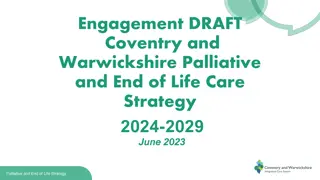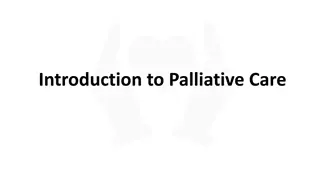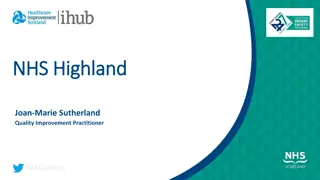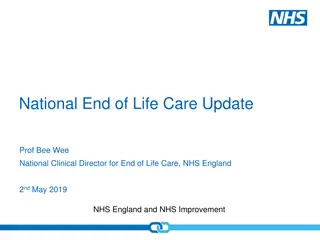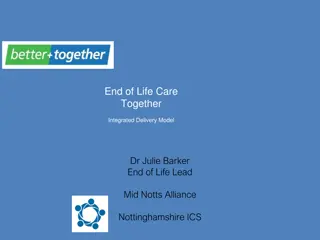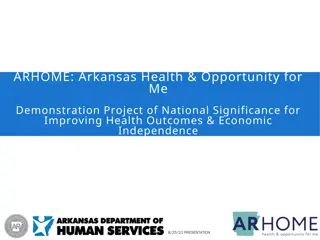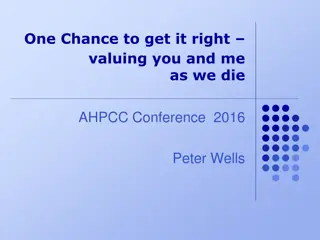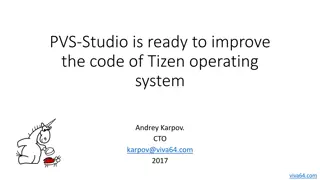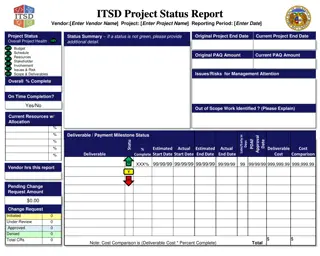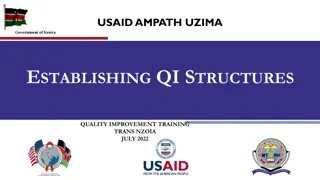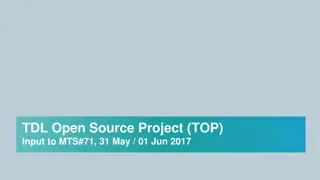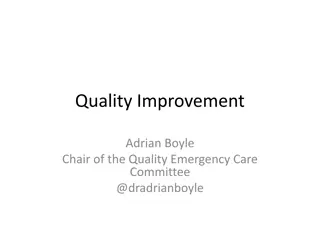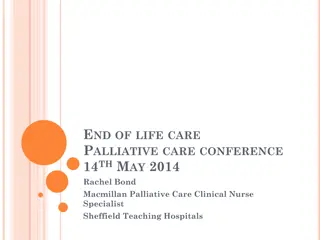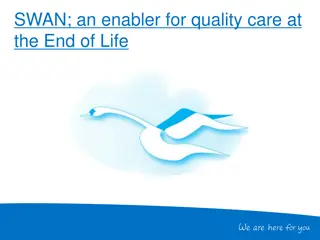Enhancing Code Status Discussions in End-of-Life Care: A Quality Improvement Project
This project led by Dr. John Rutkowski aims to reduce inappropriate interventions for patients with DNR or Modified Code Status by implementing an improved code status documentation system. Data analysis reveals a need for better documentation practices, and survey responses highlight various challenges and recommendations for improvement in code status discussions. The proposed plan includes prompts for detailed notes on code status updates to enhance patient care and safety.
Download Presentation

Please find below an Image/Link to download the presentation.
The content on the website is provided AS IS for your information and personal use only. It may not be sold, licensed, or shared on other websites without obtaining consent from the author.If you encounter any issues during the download, it is possible that the publisher has removed the file from their server.
You are allowed to download the files provided on this website for personal or commercial use, subject to the condition that they are used lawfully. All files are the property of their respective owners.
The content on the website is provided AS IS for your information and personal use only. It may not be sold, licensed, or shared on other websites without obtaining consent from the author.
E N D
Presentation Transcript
Code Status QI Project John Rutkowski, MD Hospice & Palliative Medicine Fellow FSU College of Medicine at SMH 1
Initial Project Aim July 2021 Reduce inappropriate interventions on patient s requesting a DNR or MODIFIED CODE STATUS. Provide an updated code status order along with a note reflecting the conversation that took place. 2
Proposed Plan Once a code status order is selected, providers will be prompted to fill out a brief note by checking the appropriate boxes as to what was discussed, what decisions were made, who made the decision (patient, HCS/HCP, PoA) etc. A note will be prompted with all code status updates. Code Blue note/Withdrawal of Care note; similarly, you would check boxes and a note would be generated, located under documents for all medical staff to see. There would be an [Additional Info] text box for any pertinent info as well. 3
Code Status Data We pulled data over a 6mo period and found: Total discharges: 28,946 Code status entered by time of discharge: 5,608 No code status entered by time of discharge: 23,335 Less than 20% of patients have a codes status at time of discharge. Represents 6 months: Feb - July 2021; sample size: 28,946 patient admissions Code Status Total Do Not Resuscitate 2681 (9%) FULL CODE 2576 (8%) Modified Code, Check all desired interventions 276 (0.9%) State of FL DNR (Canary Yellow) 75 (0.2%) (blank) 23,335 (80.6%) Grand Total 28,946 4
Survey Question Strongly Agree Agree Disagree Strongly Disagree Q1 Prior to admission, obtaining the code status for each patient is essential. 0 2.7% 72.7% 25% Q2 The current code status system is effective. 13.6% 0 34.09 % 11.36% 45.45 % 56.82 % 47.73 % 22.73% Q3 It is too time-consuming to obtain a code status for each admission. 0 31.82 % 40.91 % 0 Q4 Code status is not essential for every admission. 0 11.36% Q5 A screen alert would be an effective reminder for code status updates. 29.55 % 0 43.18 % 40.91 % 25% Q6 Patients and/or their families are not comfortable discussing their code status. 11.36% 47.73 % 61.36 % 20.45% Q7 Clinical staff are not comfortable discussing code status with patients and/or families. 2.27% 11.36% Q8 The inability to locate a code status in the EHR results in a Full Code error. 2.27% 29.55 % Physician 6.98% 47.73 % Resident Physician 93.02% ARNP 0 Other 0 Q9 Select your position / title. 5
Recommendations Literature review: CODE a code status improvement framework.1Code status preference is frequently ignored, misunderstood, or improperly documented, which represents a real patient safety issue resulting in preventable harm. Failures in code status discussions (CSD) can result from choice complexity, order entry errors, delayed discussion, and lack of formalized training to conduct these difficult conversations. The CODE framework provides insights and actionable guidance to improve End of Life (EOL) conversations of all types and to reduce code status error.1 C - Choice Simplification O - Order Entry Standardization D - Do Not Delay; Eliminate Deferred Discussions E - Educate the Workforce 6
Interventions Redesigning the EHR code status order to help with order entry standardization and choice simplification as well as potentially adding a screen alert Changing the hospital culture around EOL discussions and CSDs as well as reforming hospital policies on DNR discussions and mandating provider communication skills training to assist with do not defer and educating the workforce . These strategies provide ways to overcome existing barriers to proper CSDs and align the use of DNR orders closer to their intended purpose of supporting patient self-determination and avoiding non-beneficial interventions at the end of life.2 More concerted efforts from all health care professionals and decision makers are warranted to improve EOL care.3 7
Multi-Phase Approach This will allow for staff to adjust to one change at a time. Phase I: Updated code status order/note with staff education. 8
FULL CODE 10
DNR 11
Code Status changes in SCM 1. changes to Code Status order 2. new Code Status Note proposed go-live: week of 9/19/2022 13
Code Status order changes The current order has these code status and intervention choices available: Intervention choices: Modified Code can pick all above, DNR can pick from 3 on the right, FULL CODE and State of FL DNR can t pick any. Modifications to EXISTING orders will continue to look like above. NEW orders will look like below: New, required Obtained From drop down list Moved State of FL DNR Order from Code Status to Obtained From New free-text Med Decision Maker Name, Ph#, Role/Rel box only visible/required if Obtained From = Medical decision maker Intervention choices: Modified Code can pick all above, DNR can pick from 3 on the right only if Obtained From = Patient or Medical decision maker, FULL CODE and DNR Obtained From = State of FL DNR can t pick any. 14
New Code Status Note SCM will automatically create a new Code Status Note each time a Code Status order is entered or modified, pulling from the order details. The note can t be edited, canceled, or appended because it should always match the order. If note update is needed, modify the order and a new note will be created. Sample note: The note will display on the SCM Documents tab under the Patient Rights heading and it will be added to the 15. Advance Directive filter. It will not require cosignature. The changes to the Code Status order will only apply to NEW orders ; if you modify an older order, it will still look like it does now. The Code Status Note will start getting created for all orders, whether new or older modified ones. 15
Next steps Phase II: Proposal for a screen alert to target patients who are Inpatient status after a selected period of time. Notifying primary team only. Nurse education to recognize patents without a code status after several days so it can be addressed on rounds; especially patients in critical areas such as ICU. 16
Questions? 17
References: 1. CODE: A practical framework for advancing patient-centered code status discussions. A Petersen, JA Tulsky, M Mendu. BMJ Quality & Safety, April 2020. DOI 10.1136/bmjqs-2019-010791. PMID 32350129. 2. Hospital do-not-resuscitate orders: why they have failed and how to fix them. JK Yuen, MC Reid, MD Fetters Review J Gen Intern Med. 2011 Jul;26(7):791-7. DOI: 10.1007/s11606-011-1632-x. Epub 2011 Feb 1. 3. Failure to engage hospitalized elderly patients and their families in advance care planning. DK Heyland, D Barwich, D Pichora, P Dodek, F Lamontagne, JJ You, C Tayler, P Porterfield, T Sinuff, J Simon, for the ACCEPT (Advance Care Planning Evaluation in Elderly Patients) Study Team and the Canadian Researchers at the End of Life Network (CARENET) JAMA Intern Med. 2013;173(9):778-787. DOI:10.1001/jamainternmed.2013.180. 18


